《新编英汉互译教程》第三版 第一讲
- 格式:ppt
- 大小:703.50 KB
- 文档页数:20
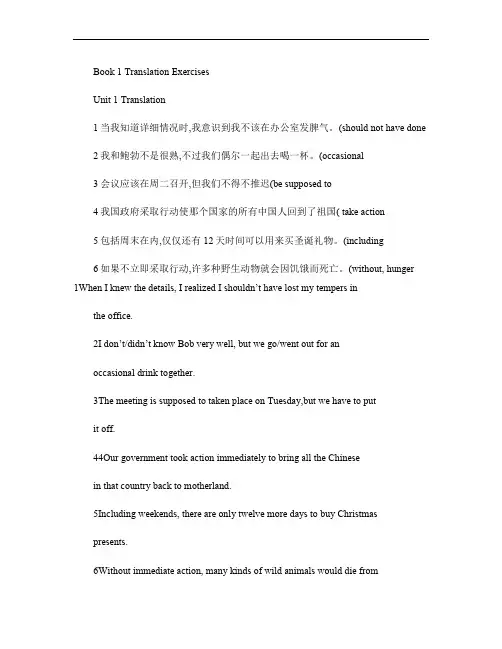
Book 1 Translation ExercisesUnit 1 Translation1当我知道详细情况时,我意识到我不该在办公室发脾气。
(should not have done 2我和鲍勃不是很熟,不过我们偶尔一起出去喝一杯。
(occasional3会议应该在周二召开,但我们不得不推迟(be supposed to4我国政府采取行动使那个国家的所有中国人回到了祖国( take action5包括周末在内,仅仅还有12天时间可以用来买圣诞礼物。
(including6如果不立即采取行动,许多种野生动物就会因饥饿而死亡。
(without, hunger1When I knew the details, I realized I shouldn’t have lost my tempers inthe office.2I don’t/didn’t know Bob very well, but we go/went out for anoccasional drink together.3The meeting is supposed to taken place on Tuesday,but we have to putit off.44Our government took action immediately to bring all the Chinesein that country back to motherland.5Including weekends, there are only twelve more days to buy Christmaspresents.6Without immediate action, many kinds of wild animals would die fromhunger.Unit 2 Translation1那首歌总是使她回想起在芝加哥度过的那个夜晚。
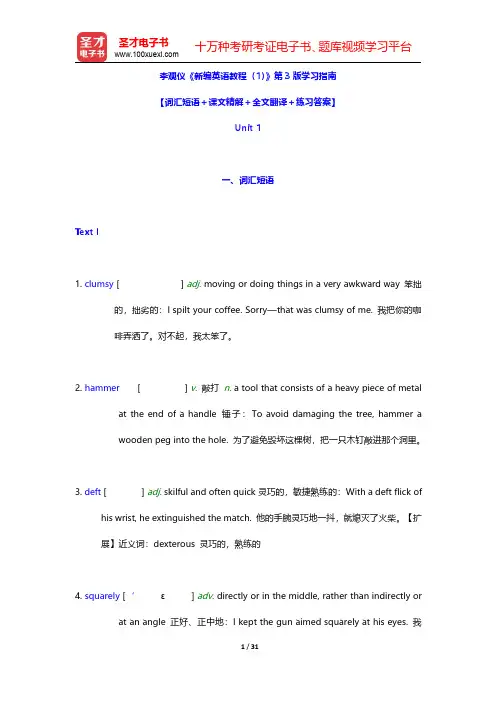
李观仪《新编英语教程(1)》第3版学习指南【词汇短语+课文精解+全文翻译+练习答案】Unit1一、词汇短语Text I1.clumsy[]adj.moving or doing things in a very awkward way笨拙的,拙劣的:I spilt your coffee.Sorry—that was clumsy of me.我把你的咖啡弄洒了。
对不起,我太笨了。
2.hammer[]v.敲打n.a tool that consists of a heavy piece of metalat the end of a handle锤子:To avoid damaging the tree,hammer awooden peg into the hole.为了避免毁坏这棵树,把一只木钉敲进那个洞里。
3.deft[]adj.skilful and often quick灵巧的,敏捷熟练的:With a deft flick ofhis wrist,he extinguished the match.他的手腕灵巧地一抖,就熄灭了火柴。
【扩展】近义词:dexterous灵巧的,熟练的4.squarely[‘ɛ]adv.directly or in the middle,rather than indirectly orat an angle正好、正中地:I kept the gun aimed squarely at his eyes.我一直把枪直直瞄准他的眼睛。
5.apt[]adj.exactly suitable适当的,恰当的:The words of this report are as apttoday as in1929.这份报告的措辞在当今如在1929年一样恰当。
6.scrupulous[]adj.correct even in the smallest detail;exact严格认真的,审慎的:You’re being very scrupulous,but to whatend?你表现得很认真,但目的是什么呢?7.subtle[]adj.not very noticeable or obvious细致的,微妙的,不易察觉的:The truth is subtly different.事实略有不同。
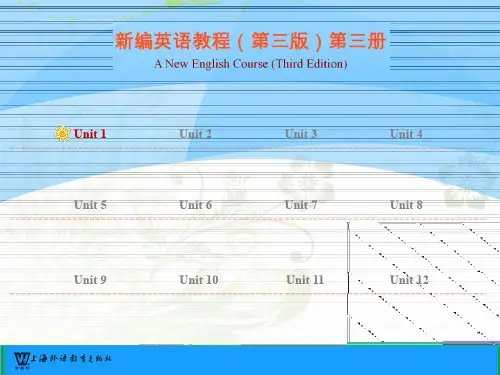
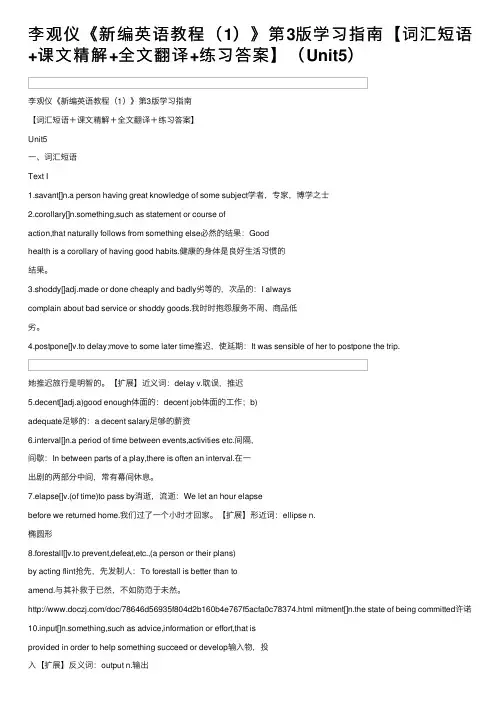
李观仪《新编英语教程(1)》第3版学习指南【词汇短语+课⽂精解+全⽂翻译+练习答案】(Unit5)李观仪《新编英语教程(1)》第3版学习指南【词汇短语+课⽂精解+全⽂翻译+练习答案】Unit5⼀、词汇短语Text I1.savant[]n.a person having great knowledge of some subject学者,专家,博学之⼠2.corollary[]n.something,such as statement or course ofaction,that naturally follows from something else必然的结果:Goodhealth is a corollary of having good habits.健康的⾝体是良好⽣活习惯的结果。
3.shoddy[]adj.made or done cheaply and badly劣等的,次品的:I alwayscomplain about bad service or shoddy goods.我时时抱怨服务不周、商品低劣。
4.postpone[]v.to delay;move to some later time推迟,使延期:It was sensible of her to postpone the trip.她推迟旅⾏是明智的。
【扩展】近义词:delay v.耽误,推迟5.decent[]adj.a)good enough体⾯的:decent job体⾯的⼯作;b)adequate⾜够的:a decent salary⾜够的薪资6.interval[]n.a period of time between events,activities etc.间隔,间歇:In between parts of a play,there is often an interval.在⼀出剧的两部分中间,常有幕间休息。

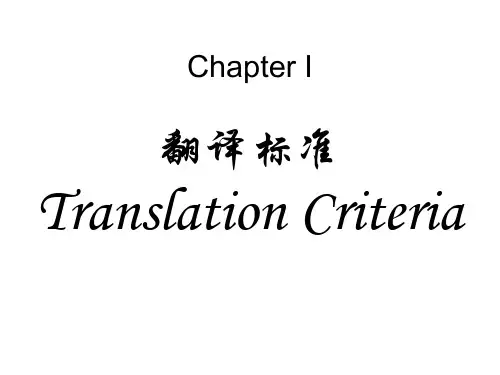
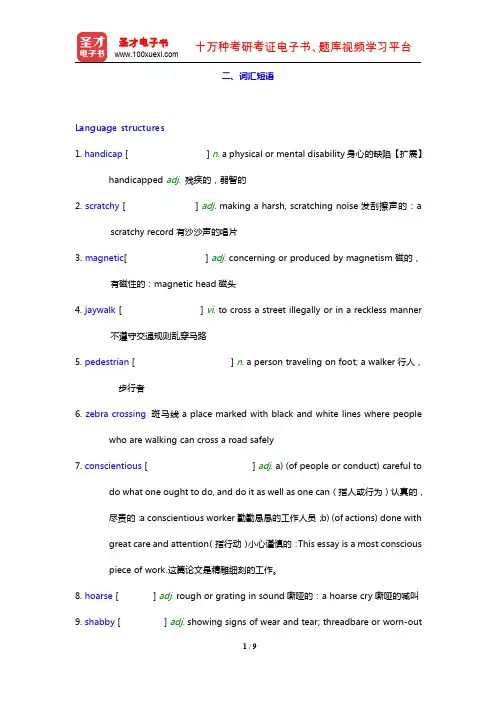
二、词汇短语Language structures1.handicap[]n.a physical or mental disability身心的缺陷【扩展】handicapped adj.残疾的,弱智的2.scratchy[]adj.making a harsh,scratching noise发刮擦声的:ascratchy record有沙沙声的唱片3.magnetic[]adj.concerning or produced by magnetism磁的,有磁性的:magnetic head磁头4.jaywalk[]vi.to cross a street illegally or in a reckless manner不遵守交通规则乱穿马路5.pedestrian[]n.a person traveling on foot;a walker行人,步行者6.zebra crossing斑马线a place marked with black and white lines where peoplewho are walking can cross a road safely7.conscientious[]adj.a)(of people or conduct)careful todo what one ought to do,and do it as well as one can(指人或行为)认真的,尽责的:a conscientious worker勤勤恳恳的工作人员;b)(of actions)done withgreat care and attention(指行动)小心谨慎的:This essay is a most consciouspiece of work.这篇论文是精雕细刻的工作。
8.hoarse[]adj.rough or grating in sound嘶哑的:a hoarse cry嘶哑的喊叫9.shabby[]adj.showing signs of wear and tear;threadbare or worn-out破旧的,褴褛的:be shabby in dress衣衫褴褛10.brochure[]n.a small booklet or pamphlet小册子11.sewage[]n.liquid and solid waste carried off in sewers ordrains下水道的污物12.renovate[]vt.restore(esp.old buildings)to goodcondition修复(尤指旧建筑物),整修:The house has been renovated threeyears earlier.这所房子三年前就已翻新。

第1单元避免两词铭记两词在生活中,没有什么比顿悟更令人激动和兴奋,它可以变化一种人——不但仅是变化,并且变得更好。
固然,这种顿悟是很罕见,但依然可以发生在我们所有人身上。
它有时来自一本书,一种说教或一行诗歌,有时也来自一种朋友。
在曼哈顿一种寒冷冬天下午,我坐在一种法国小餐馆,倍感失落和压抑。
由于几次误算,在我生命中一种至关重要项目就这样落空了。
就由于这样,甚至连盼望看到一种老朋友(我经常私下亲切想到一种老人)情形都不像此前那样令我兴奋。
我坐在桌边,皱起眉头看着色彩多样桌布,苏醒嚼着苦涩食物。
她穿过街道,裹着旧棉袄,一顶帽子从光头打下来,看上去不像是一种有名精神病医生,倒像是一种精力充沛侏儒。
她办公室在附近处处均有,我懂得她刚刚离开她最后一种病人。
她接近80岁,但依然扛着一种装着满满文献公文包,工作起来依然像一种大公司主管,无论何时有空,她都依然爱去高尔夫球场。
当她走过来坐我旁边时,服务员早已把她总是要喝啤酒端了过来,我已经几种月没有见她了,但她似乎还是老样子。
没有任何寒暄,她就问我“怎么了,年轻人?”我已经不再对她样子感到奇怪,因此我详细地把烦恼告诉她。
带着一丝忧伤自豪。
我尽量说出实情,除了我自己,我并没有由于失望而责怪任何人。
我分析了整件事情,但所有负面评价以及错误依然继续。
我讲了约有十五分钟,这期间老人只是默默喝着啤酒。
我讲完后,她取下眼镜说:“到我办公室去。
”“到你办公室?你忘了带什么了吗?”她和蔼说“不是,我想看看你对某些事情反映,仅此而已。
”外面开始下起小雨,但她办公室很温暖,舒服,亲切:放满书书架靠着墙壁,长皮沙发,弗洛伊德亲笔签名照,尚有墙边放着录音笔。
她秘书回家了,只有我们在那里。
老人从纸盒里拿出一盘磁带放进录音笔,然后说:“这里有到我这来求助三个人简朴录音,固然,这没有阐明详细是哪三个人。
我想让你听听,看你与否能找出双字词短语,这里是在三个案例中共有。
”她笑道:“不要这样困扰,我有我目。
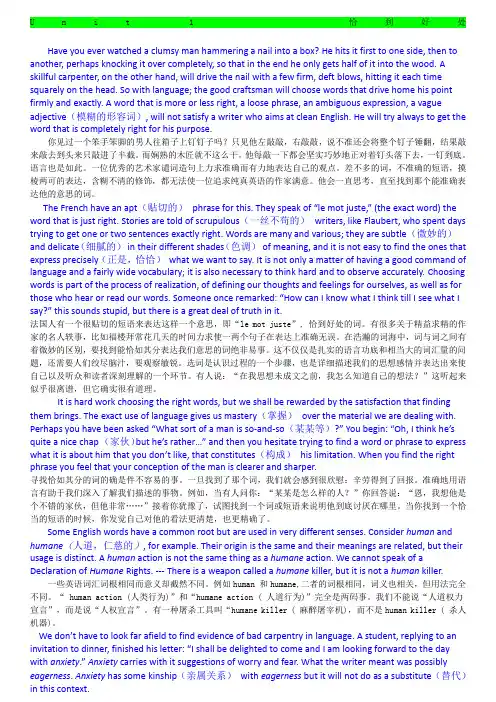
U n i t1恰到好处Have you ever watched a clumsy man hammering a nail into a box? He hits it first to one side, then to another, perhaps knocking it over completely, so that in the end he only gets half of it into the wood. A skillful carpenter, on the other hand, will drive the nail with a few firm, deft blows, hitting it each time squarely on the head. So with language; the good craftsman will choose words that drive home his point firmly and exactly. A word that is more or less right, a loose phrase, an ambiguous expression, a vague adjective(模糊的形容词), will not satisfy a writer who aims at clean English. He will try always to get the word that is completely right for his purpose.你见过一个笨手笨脚的男人往箱子上钉钉子吗?只见他左敲敲,右敲敲,说不准还会将整个钉子锤翻,结果敲来敲去到头来只敲进了半截。
而娴熟的木匠就不这么干。
他每敲一下都会坚实巧妙地正对着钉头落下去,一钉到底。
语言也是如此。
一位优秀的艺术家谴词造句上力求准确而有力地表达自己的观点。
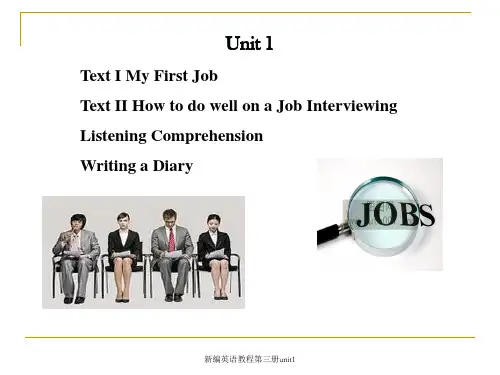
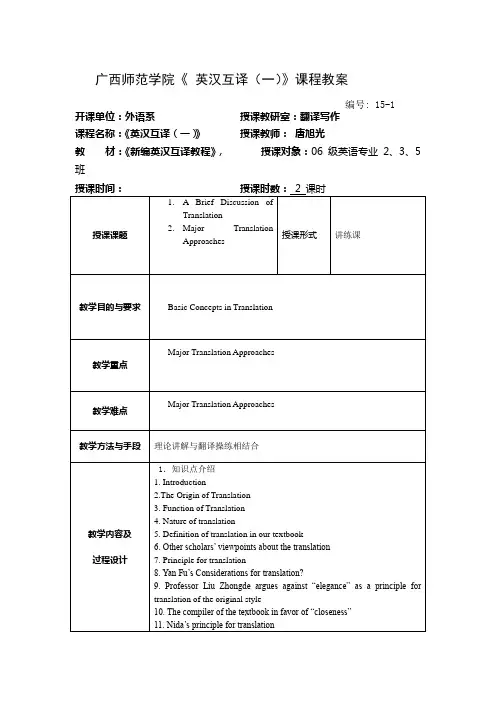
广西师范学院《英汉互译(一)》课程教案编号: 15-1 开课单位:外语系授课教研室:翻译写作课程名称:《英汉互译(一)》授课教师:唐旭光教材:《新编英汉互译教程》,授课对象:06级英语专业2、3、5班《英汉互译(一)》第一讲翻译简论与主要翻译方法(A Brief Discussion of Translation and Major Translation Approaches)1. IntroductionTranslation studies started along with translation practice. Translation theories developed flourishingly in the 20th century, especially in the second half of the last century.In fact, translation, which is a very complex phenomenon, is related to different disciplines, such as linguistics, psychology, sociology, cultural anthropology, communication theory, literary criticism, aesthetics, and semiotics. As translation study is a cross-discipline and cross-culture subject involving many aspects of human knowledge, the lack of a fully acceptable theory of translation should not come as a surprise. Meanwhile, quite a number of translation approaches and strategies have become universally acceptable and widely applicable. They are, of course, the fruits of many translation theorists and translation practitioners at home and abroad.2.The Origin of TranslationLanguage makes it possible for people to communicate with one another freely so as to complete important tasks in human life. Translation makes it possible for people from different languages to communicate with one another so as to complete important tasks in their life.Theodore Savory points out, “Translation is almost as old as original authorship and has a history as honorable and as complex as that of any other branch of literature”(申雨平, 2002:4).In Zhou Dynasty there were different forms of address for translators in different places. “Translators are called Ji in the east, Xiang in the south, Didi in the west, andYi in the north(东方曰寄,南方曰象,西方曰狄鞮,北方曰译)”(陈福康, 2000:3).3. Function of TranslationIt has helped people to better communicate with one another, and in the mean time it has facilitated the development of culture and civilization of all nations, such as the Sutra translation (佛经翻译)in China and the Bible translation in Western countries.Actually, translation, as a means to bridge different cultures, has been playing a very important role in promoting global economic and cultural development, and China in particular benefits a great deal from translation, which is obvious to all.4. Nature of translationOne school of theorists maintain that any interpretation is translation. Translation thus defined includes intra-lingual rewording(语言内的重新措辞), inter-lingual (语言之间的翻译或语际翻译)translation and inter-semiotic transmutation(符号转换).But most scholars who are interested in translation maintain that translation is a communicative activity which entails a most adequate or identical reproduction in a target language of a written message or text in a source language.5. Definition of translation in our textbook as follows: Translation or translating is a communicative activity or dynamic process in which the translator makes great effort to thoroughly comprehend a written message or text in the source language and works very hard to achieve an adequate or an almost identical reproduction in the target language version of the written source language message or text. In terms of its nature or character, translation is both an art and a science as well, since it calls for a good command of at least two languages, a flexible application of their rules, and some knowledge of at least two cultures, as well as a good grasp of the necessary translation theories.6. Other scholars’ viewpoints about the translation1). The traditional viewpoint about the nature of translation is that translation is an art only. This viewpoint is still maintained by Xu Yuanchong(许渊冲), a well-known professor at Beijing University, and a few other scholars.2). Professor Liu Zhongde vigorously advocates that translation is a science as well as an art mainly because of the following reasons:Firstly, like any other art and science, translation requires a good grasp and a flexible use of the necessary specialized knowledge and skills.Secondly, like any other art and science, translation calls for independent, honest and creative effort.Thirdly, just like any other art and science, translation demands that the translator be very careful about and highly responsible for his or her work.7. Principle for translationThe 13 statements on page 81). A translation must reproduce the words of the SLT(Source Language Text).2). A translation must reproduce the ideas (meaning) of the SLT.3). A translation should read like an original work.4). A translation should read like a translation.5). A translation should reflect the style of the original.6). A translation should possess the style of the translator.7). A translation should retain the historical stylistic dimension of the SLT.8). A translation should read as a contemporary piece of literature.9). A translation may add to or omit from the original.10). A translation may never add to or omit from the original.11). A translation should let the readers of the SLT and the target language text (TLT) have essentially the same response.12). A translation should convey what the SLT author intends to convey.13). A translation should satisfy the need of the client.Evidently, though each of the above statements is right in a certain sense, yet it is not adequate or comprehensive enough to serve as a translation principle. Some of the principles proposed by various translation theorists can find their expression in the statements given above. Interlinear translation is an illustration of the first statement. Yan Fu’s three-character principle can be a combination of statements 2, 3 and 6. Nida’s functional equivalence is best express ed in statement 11.8. Yan Fu’s Considerations for translation?Strictly speaking, a translation theory in its true sense in China originated from Yan Fu(严复). He proposed the famous triple principle for translation, namely, faithfulness(信), expressiveness(达) and elegance(雅).1). His faithfulness means that the translated text should be faithful to the original text, ie, the version should keep the content or ideas of the original.2). His expressiveness means that the translated text should be expressive and coherent without anything awkward. In other words, his expressiveness requires that the version should be fluid, smooth, and easy to read and understand.3). His elegance demands that the translated text should be exquisite and that its style ought to be very graceful.9. Professor Liu Zhongde argues against “elegance” as a principle for translation of the original styleHe argued eloquently against “elegance” as a principle for translation of the original style. We all know that not all works are characterized by the elegant style. Different writers display different styles. For instance, Lenin wrote in a bold style, and Hemingway wrote in a simple, symbolic style. Even the same writer shows different styles on different occasions for different purposes. Naturally, different works demonstrate different styles. Thus, it is impossible & absolutely wrong to achieve the effect of elegance in the translated text if the style of the original is not elegant.10. The compiler of the textbook in favor of “closeness”1). We are in favor of Professor Liu’s triple translation principle. He changed Yan Fu’s “elegance” into “closeness”, which represents his contribution to the translation theory. His “closeness” is central in meaning. It is suitable for translation of all types of texts with different styles.2). If the original text is characterized by the elegant style, the translator should do his utmost to render it into a graceful text in the target language whose style is close to the original elegant style.If the original style is highly technical with a wealth of technical terms, thetranslator ought to employ plenty of corresponding technical terms in the target language and make the translated style as close to the original technical style as possible.3). If the original style is colloquial with a lot of informal words and colloquial sentences, the translator should translate it into a text with an informal style as close as possible to the original one by using many colloquial words and informal sentences.If the original style is ornate, the translator should follow suit and make effort to render the translated style as close to the original as possible.If the original text contains some vulgar words and sentences, the translator is not entitled to replace them with elegant words or sentences, and he should reproduce the original by using some corresponding vulgar words and sentences in the receptor language. Translators are duty-bound to do so, for the simple reason that they are translators.4). As we know, Yan Fu’s triple translation principle is highly concise and well rhymed and quite easy to learn by heart, which is one of the reasons why it is still very popular in China today.Professor Liu’s triple principle is similar to Yan Fu’s in that it is equally concise and easy to remember.Though Professor Liu’s triple principle is n ot rhymed, yet it is very forceful and impressive, for the Chinese character “切” is uttered in the falling tone, carrying the implication that faithfully conveying the original style or rendering the translated style as close to the original as possible is absolutely necessary and worth the translator’s great effort.11. Nida’s principle for translationEugene A. Nida and Taber stated emphatically (1969:12): “Translation consists in reproducing in the receptor language the closest natural equivalence of the source language message, first in terms of meaning and secondly in terms of style”.His dynamic equivalence is defined as a translation principle, according to which the translator seeks to translate the meaning of the original in such a way that the target language text wording will produce the same impact on the target text audience as the original wording does upon the source text audience. Later on, Nida changed “dynamic equivalence” into “functional equivalence”, because it seemed much more satisfactory to use the expression “functional equivalence” in describing the degree of adequacy of a translation.12. The literal translation approachProfessor Liu Zhongde (1994: 172) defines literal translation as follows: “In the process of translation, literal translation treats sentences as basic units and at the same time takes the whole passage into consideration; a translator who attaches great importance to literal translation does his or her best to reproduce the ideas and writing style of the original work, retaining in the version as many rhetorical devices and sentence structures of the original as possible.”ExamplesHe is said to be a rough diamond.人们说他是一块浑金璞玉。
1.当我知道了详细情况时,我意识到我不该在办公室发脾气(should not have done)When I knew the details I realized that I should not have lost my temper in the office.2.我与鲍勃(Bob)不是很熟,不过我们偶尔一起出去喝一杯。
(occasional)I don’t / didn’t know Bob very well, but we go / went out for an occasional drink together.3.会议应该在周二召开,但我们不得不推迟。
(be supposed to )The meeting is supposed to take place on Tuesday, but we have to postpone it / put it off.4.我国政府采取行动使那个国家的所有中国人回到了祖国。
(take action)Our government took action to bring / get all the Chinese in that country back to China.5.包括周末在内,仅仅还有12天时间可以用来买圣诞礼物。
(including)Including weekends, there are only 12 more days to buy Christmas presents / gifts.6.如不立即采取行动,许多种野生动物就会因饥饿而死亡。
(without, hunger)Without immediate action, many kinds / species of wildanimals would die from hunger.1.那首歌总是使她回想起在芝加哥度过的那个夜晚。
(reminded her of)That song always reminded her of the night she spent in Chicago.2.街角处刚巧有一位警察,我便向他问路。
TranslationUnit 11. 由于缺少资金,整个计划失败了。
(fall through)The whole plan fell through for want of fund.2. 牛顿被公认为是世界上最杰出的科学家之一。
(eminent)Newton is acknowledged as one of the world’s most eminent scientists.3. 他对生产成本的估算总是准确无误。
(invariable)He calculates the cost of production with invariable accuracy.4. 公司发言人的不负责任讲话受到了严厉指责。
(berate)The spokesman of the corporation was berated for his irresponsible words.5. 这名商业银行的年轻职员看出那张十英镑的假币。
(spot)The young clerk from the commercial bank spotted the counterfeit ten-pound note.6. 这个精干的经理立刻行动了起来。
(promptly)The efficient manager acted promptly.7. 请把候补名单上她的名字换成你的名字。
(substitute)Please substitute her name for yours on the waiting list.8. 她觉得她在当地综合医院任实习医师是一段宝贵的经验。
(rewarding)She found that her internship in the local general hospital was a rewarding experience.9. 不要感叹过去的不幸,振作起来向前看。
(lament)Don’t lament your past misfortunes. Keep your chin up and look to the future.Unit 21. 富兰克林在他的《自传》里力劝读者要勤俭。